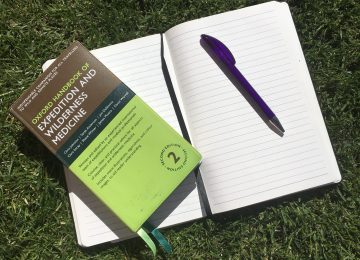
This is a very dry topic, so I’m sorry in advance, but it’s very important for medical and mountain professionals!
Introduction
Medical record keeping is just as important on expedition as it is in hospital or in primary care. There is no reason high standards of record keeping are not met and it is in the medic’s interests to ensure this.
We keep detailed notes because:
- They aid diagnosis and treatment.
- They enable disease progression to be easily tracked (we can clearly see trends of improvement or deterioration – remember to document each time you reassess the patient e.g. basic observations: GCS (Glasgow coma score, HR (heart rate), RR (Respiratory rate), O2 sats, temperature, pain score, blood sugar, fluid input/output).
- They aid handover e.g. to evacuating team or local facility staff in country, or to GP at home.
- They act as a record of what has been done and why (and not done in some cases) – this is your strongest defence in the event of any legal action, (or it could be your weakest defence if not done well!).
As with all medical documentation, the following must be included:
- Patient information: name, DoB
- Date & time
- Location
- Your details: name, grade, signature
- Patient history, clinical assessment, working diagnosis, treatment/interventions and your thought process.
Note taking practicalities
Notes should be written at the time or with minimal delay to ensure details aren’t forgotten, and so that if the patient’s condition changes, the previous notes can be easily accessed to aid assessment and treatment.
We all have different ways of keeping notes on expedition and it may depend on the type of environment you are in e.g. humid rainforest vs. dry desert. Consider before you go what might work best for you – electronic or paper and in what format. Will you be able to ensure a good battery supply for your electronics? Do you have a back-up system? How will you give the information to someone else should you need to hand the patient over? If you prefer paper, ensure it is kept in best condition possible, as it is a legal document. Potentially using a combination of methods may work best.
Remember that notes must be kept confidential during and after the expedition. The medic should also keep a copy for later reference.
There are situations on an expedition where you may feel that writing notes is unnecessary because the situation is too minor e.g. giving advice to someone about their blister that they are managing well. Be pragmatic, avoid wasting time and energy writing down every tiny detail of the expedition. Medics will find their own comfort level in terms of what to document and to what level of detail. For any issue, even if apparently minor at the time, my general rule (although there are always exceptions) is that if I have intervened with a treatment (including blister care), I tend to document something on the person’s diary sheet (see tips at the end).
Serious incident reporting
In the event of a serious incident on expedition, an incident report must be written.
This should include:
- Site and time of incident
- People involved directly and any witnesses
- What happened
- What action was taken
- The outcomes
- Keep it factual
My tips to make documentation easier on expedition:
- I often make quick notes on my phone at the time if I’m doing a quick assessment/treatment whilst trekking. I then write these up in the evening once in the tent so I have a backup and more time for further details if required.
- I take a pre-made sheet for every expedition member to write notes after each formal consultation and any notes from daily ‘check ins’. It’s simply a sheet of paper with the person’s details at the top that can then act like a basic medical
- I bring pre-made spreadsheets with everyone’s names and daily columns of basic observations like O2 saturations and HR, which I check daily (usually in the evening in the mess tent or similar) whilst ascending to altitude. (Note that differences in O2 sats/HR between team members is expected at altitude. Don’t panic about the person with the lowest O2 sats if they are clinically very well as monitoring trends and clinical correlation is the most important thing).
- I bring pre-made detailed observations charts (g. hospital NEWS chart or similar) to document observations for more sick/injured patients who require more regular monitoring.
- I carry templates of a ‘Casualty Card’ for emergencies (link on my References page). I print them on waterproof paper so they don’t smudge or tear easily. It is extremely helpful not only to aid documentation but also to use as a memory aid.

Pingback: The Role Of Expedition Medic: What It Really Involves - Dr. Hannah Lock